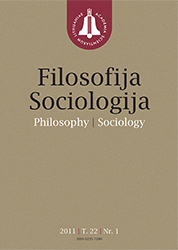Metaphor of Existence: Seafaring and Shipwreck
Metaphor of Existence: Seafaring and Shipwreck
Author(s): Lina VidauskytėSubject(s): Christian Theology and Religion, Anthropology, Recent History (1900 till today), Contemporary Philosophy, Philosophy of Religion, Philosophy of Language, Hermeneutics
Published by: Lietuvos mokslų akademijos leidykla
Keywords: Myth; logos; metaphor; existence; care; seafaring; Gnosticism; shipwreck;
Summary/Abstract: The paper focuses on the metaphor of existence as a way of philosophical talking about life. Metaphorology was introduced by Hans Blumenberg (1920–1996), one of the most important and innovative thinkers of the 20th century. The works of Blumenberg fall generally within the category of the hermeneutics of metaphor. It is, for him, the question of substituting the study of the more hidden work of metaphors, symbols, and myths for the traditional history of concepts and doctrines. One can say there are two inextricable elements of Blumenberg’s thought: (1) a theory of nonceptuality as essential to philosophizing and (2) an exploration of culture understood as humanity’s unceasing attempts to relieve itself of the weight of the absolutism of reality. Metaphors play an important role in the philosophical language: they are not impediments to clear thinking and clear expression, but rather they are images, iconic constants used by philosophers. Metaphors are able to grasp the reality better than philosophical concepts. According to Blumenberg, metaphors are a kind of reality models, the work of human imagination. One of such models is the metaphor of seafaring/shipwreck and the present article focuses on multiple actualizations of the metaphor in Blumenberg’s philosophy
Journal: Filosofija. Sociologija
- Issue Year: 2017
- Issue No: 1
- Page Range: 11-19
- Page Count: 9
- Language: English

